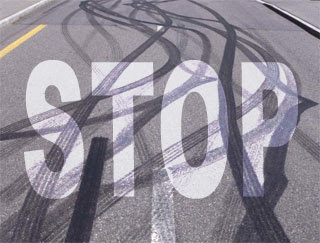 BRAKING AWAY
BRAKING AWAYMany drivers in the last few weeks will have experienced, perhaps taken by real surprise at the dreadful road conditions (no not those dreadful potholes now appearing – another story later) the ones late being gritted or not even at all.
Watching drivers in front who have not got their timing correct as to regards braking, still coming into bends, hazards, and not allowing for the state of the road, the need to look ahead further plan the speed, off the gas pedal (accelerator) much earlier and maintain a safe speed without harsh braking. Looking in all Mirrors before easing foot from the gas pedal, yes we look in the mirrors, not check the mirrors by checking we just confirm the mirror is there. It is important to look and act on what we see.
Drivers with the timing wrong and being caught in emergency situations could give themselves undue problems. Many of you will remember on your driving test the words “I want you to stop promptly and under full control as if, a small child has run out in front of your vehicle”.
This was in the good old days, in today’s modern driving test only about 1 in 3 drivers are asked to perform an emergency stop, I still say every test candidate should show their ability or is it now not important to avoid a small child as it used to be!!
However every new driver is taught during their driver training on how to stop under full control, simulated emergency stops including all types of new technology and vehicle design (ABS).
One of the areas of debate relating to stop quickly is the use of “cadence braking” on vehicles without anti-lock brakes (ABS SYSTEMS).
A company driver I was with this week was telling the story of his best friend who was driving a car without ABS and panicked in a braking situation, locked the wheels an crashed into a vehicle in front causing lots of damage.
When stopping, your car is dependant upon friction between the tyre and road surface. So lets keep it simple.
When stopping there is maximum friction gained at a point just before the wheels lock (this being the threshold) and where we see about 15 per cent wheel slip.
Therefore drivers need to hold the brakes on the threshold of lock up in order to stop in the shortest possible distance, this technique is named threshold braking.
Threshold braking can cause problems and highlight two important factors:
The driver needs to have a high degree of skilled finesse within the use of the cars controls, and skill in emergency braking.
ALSO being aware of maintaining the threshold as grip changes due to road surfaces, dirt, gravel, oil..
Because drivers only practice this with their run up to a driving test, the panic sets in when faced with real emergency, so the chances of threshold braking then becomes very remote.
Cadence Braking is the pumping action of the brake pedal, which on a non ABS fitted vehicle the driver would do to stop the vehicle skidding.
Here we need to be careful, as pumping the pedal may prolong your stopping distance, during the pumping action even if the brakes are not fully released more distance is lost within the brakes off phase than would be lost with a skidding tyre.
Many drivers with vehicles not fitted with anti lock brakes find it very hard to get finesse in braking, so as to not lock wheels.
So on good dry roads get to a threshold brake, but on more slippery surface bring in the cadence braking, by braking to lock up– then release the pedal pressures –lock up –then release and so on until you stop.
Cadence braking enables you to maintain control, wheels can only steer when they are gripping the road,
maintaining control reduces risk of rear wheels leaving the road because of weight moving more to the front, which could cause car to spin and your whole world turns upside down.
In an emergency, it is brake, then clutch down because if the clutch goes down and the engine is disengaged before the brakes really bite the driver may sense a surge which in turn causes panic and could destabilise the vehicle. At the same time you must keep both hands on wheel (in order to keep car under control) and push your back into the back rest of the seat.
The best advice look ahead plan you journey, drive with a big picture all around the vehicle, don’t be taken by surprise, keep full control and leave space around the vehicle.
However from time to time you may have lost concentration or something unexpected developed, so if you have had to stop suddenly more than twice in the last 100,000 miles think about refreshing your skills, as you could become one of the unfortunate victims on our roads who really did come to a DEAD STOP !!
The advantage of vehicles with ABS is that the vehicle can be steered through braking, you will also feel the pumping action within the braking system…










